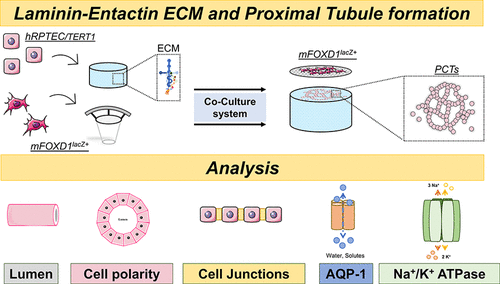当前位置:
X-MOL 学术
›
ACS Biomater. Sci. Eng.
›
论文详情
Our official English website, www.x-mol.net, welcomes your feedback! (Note: you will need to create a separate account there.)
Matrigel-Free Laminin–Entactin Matrix to Induce Human Renal Proximal Tubule Structure Formation In Vitro
ACS Biomaterials Science & Engineering ( IF 5.8 ) Pub Date : 2020-11-16 , DOI: 10.1021/acsbiomaterials.0c01385 M Adelfio 1 , S Szymkowiak 1 , D L Kaplan 1
ACS Biomaterials Science & Engineering ( IF 5.8 ) Pub Date : 2020-11-16 , DOI: 10.1021/acsbiomaterials.0c01385 M Adelfio 1 , S Szymkowiak 1 , D L Kaplan 1
Affiliation

|
A successful in vitro tissue model must recapitulate the native tissue features while also being reproducible. Currently, Matrigel is the principal biomaterial used to induce the formation of proximal convoluted tubules (PCTs) in vitro, because of its similar composition and structure with the kidney tubular basement membrane and the presence of critical growth factors. However, Matrigel is not well-defined, and batch-to-batch variability is a significant issue. Here, we define a Matrigel-free method, using a laminin–entactin (L–E) matrix to support the formation of proximal tubular-like structures in vitro using immortalized human renal epithelial cells (RPTEC/TERT1) cocultured with murine fibroblast stromal cells (FOXD1lacZ+). The matrix supports the presence of specific components of the tubular basement membrane (laminin, entactin/nidogen, and heparan sulfate proteoglycan) in addition to fibroblast growth factor 8a (FGF-8a). The matrix also induces tubulogenesis, leading to the formation of PCTs based on several key markers, including E-cadherin, aquaporin-1, and Na+/K+ ATPase. Moreover, these PCT structures displayed cell polarity and a well-defined lumen after 18 days in culture. This laminin–entactin (L–E) matrix constitutes a defined and consistent biomaterial that can be used in kidney tissue engineering for understanding in vitro proximal tubule development and for nephrotoxicity studies.
中文翻译:

体外诱导人肾近端小管结构形成的无基质层粘连蛋白-Entactin 基质
一个成功的体外组织模型必须概括原生组织特征,同时还具有可重复性。目前,Matrigel 是用于在体外诱导近曲小管 (PCT) 形成的主要生物材料,因为它与肾小管基底膜的组成和结构相似,并且存在关键的生长因子。然而,Matrigel 的定义并不明确,批次间的差异性是一个重要问题。在这里,我们定义了一种无基质胶的方法,使用层粘连蛋白-entactin (L-E) 基质来支持在体外使用永生化人肾上皮细胞 (RPTEC/TERT1) 与鼠成纤维细胞基质细胞共培养近端管状结构的形成(FOXD1 lacZ+)。除了成纤维细胞生长因子 8a (FGF-8a) 外,该基质还支持管状基底膜的特定成分(层粘连蛋白、致动蛋白/巢蛋白和硫酸乙酰肝素蛋白聚糖)的存在。该基质还诱导肾小管发生,导致基于几个关键标志物的 PCT 形成,包括 E-cadherin、aquaporin-1 和 Na + /K + ATPase。此外,这些 PCT 结构在培养 18 天后显示出细胞极性和明确的管腔。这种层粘连蛋白-entactin (L-E) 基质构成了一种明确且一致的生物材料,可用于肾组织工程,以了解体外近端小管发育和肾毒性研究。
更新日期:2020-12-14
中文翻译:

体外诱导人肾近端小管结构形成的无基质层粘连蛋白-Entactin 基质
一个成功的体外组织模型必须概括原生组织特征,同时还具有可重复性。目前,Matrigel 是用于在体外诱导近曲小管 (PCT) 形成的主要生物材料,因为它与肾小管基底膜的组成和结构相似,并且存在关键的生长因子。然而,Matrigel 的定义并不明确,批次间的差异性是一个重要问题。在这里,我们定义了一种无基质胶的方法,使用层粘连蛋白-entactin (L-E) 基质来支持在体外使用永生化人肾上皮细胞 (RPTEC/TERT1) 与鼠成纤维细胞基质细胞共培养近端管状结构的形成(FOXD1 lacZ+)。除了成纤维细胞生长因子 8a (FGF-8a) 外,该基质还支持管状基底膜的特定成分(层粘连蛋白、致动蛋白/巢蛋白和硫酸乙酰肝素蛋白聚糖)的存在。该基质还诱导肾小管发生,导致基于几个关键标志物的 PCT 形成,包括 E-cadherin、aquaporin-1 和 Na + /K + ATPase。此外,这些 PCT 结构在培养 18 天后显示出细胞极性和明确的管腔。这种层粘连蛋白-entactin (L-E) 基质构成了一种明确且一致的生物材料,可用于肾组织工程,以了解体外近端小管发育和肾毒性研究。


























 京公网安备 11010802027423号
京公网安备 11010802027423号